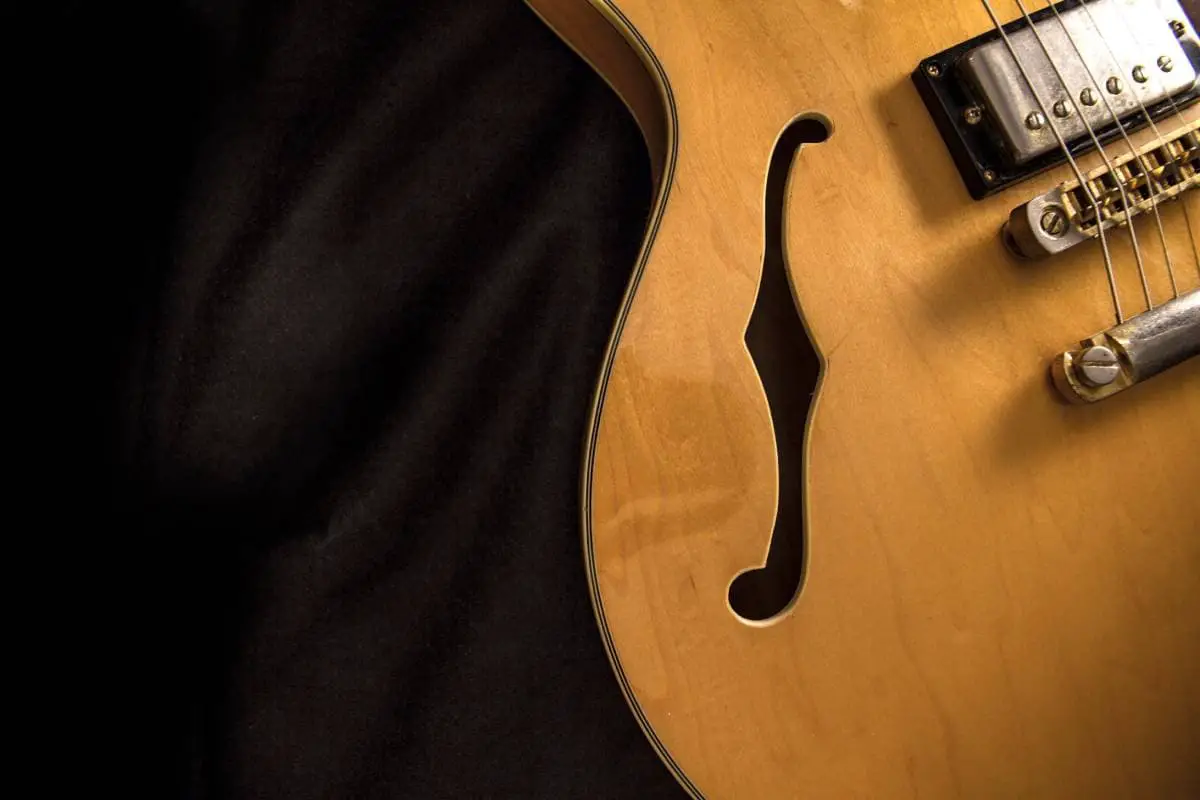The soundhole is a huge part of the design of an acoustic guitar, usually sitting right in the middle of the soundboard. While it might seem like its only purpose is to swallow picks and never to let them out again, it actually plays a crucial role in the functioning of your guitar.
Soundholes amplify the sound of your guitar and help create it. A soundhole focuses sound waves on a single spot and directs them toward the listener, which makes the sound louder. A soundhole also makes the soundboard lighter, allowing it to vibrate more easily.
This article will examine the role of soundholes on acoustic guitars. We’ll also mention their role on electric guitars, and we’ll examine why you might sometimes have to cover your soundhole.
👇😀👇NOTE👇😀👇
If you want to find out what my recommended guitar gear is, then here is what I recommend on Amazon:
- Fender Cutaway Acoustic-Electric Guitar Bundle (MY FAVORITE GUITAR)
- Snark SN-8 Super Tight All Instrument Tuner (Easiest Tuner I’ve Used😏)
- 6 String Acoustic Guitar Capo (Best CAPO for quick changes)
- Dunlop Max Grip 1.0mm Nylon Picks (Thick Guitar Pick So You Don’t Lose Grip!)
- Universal Guitar Stand (Cheap & Minimalist Guitar Stand I Recommend)
- Levy’s 2″ Wide Quick Adjust Guitar Strap (Best Guitar Strap For Any Level)
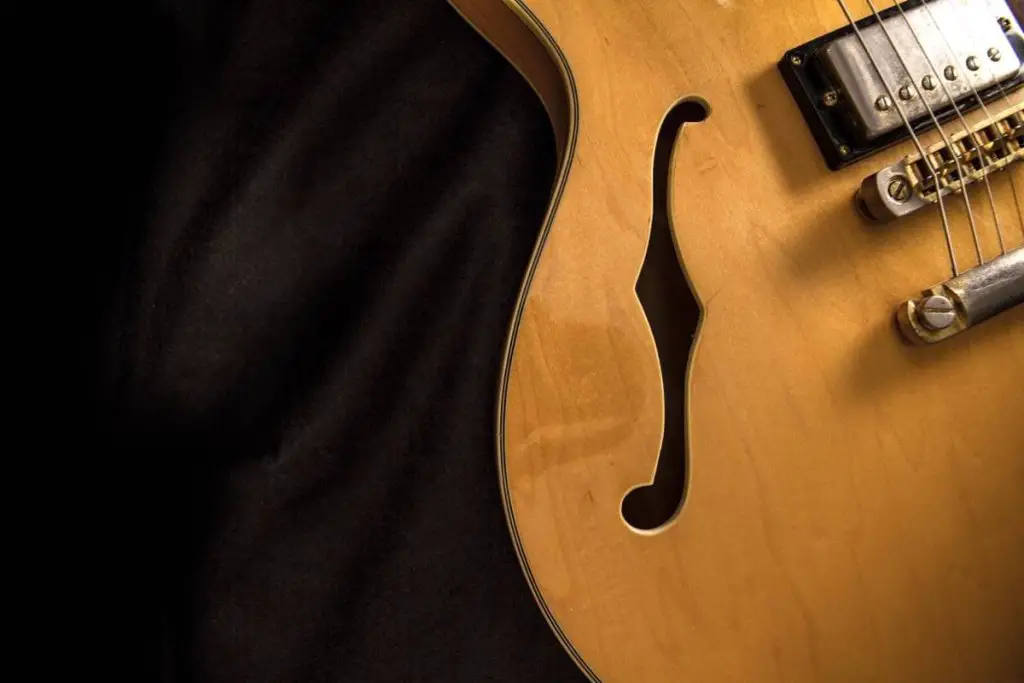
How Guitars Create Sound
In a nutshell, sound is vibration. When an object vibrates, it stirs molecules of air, which in turn bump into their neighbor molecules. As the molecules bump into each other, sound waves are created. This motion travels to our eardrums, which also vibrate.
What we hear depends on the strength of the initial vibration and the medium it travels through. This is easily observable in guitars. Strumming harder will always create a louder sound, and different materials can create different sounds.
When it comes to acoustic guitars, the sound is created by picking or strumming the strings and causing them to vibrate. The vibration is then transferred to the guitar’s bridge, which causes the soundboard to vibrate.
These vibrations make the air in the guitar’s body vibrate as well. The vibration is released through the sound hole, which gives us the sound we love.
Electric guitars also depend on vibrations, but the mechanism is vastly different. The strings vibrate, of course, but these vibrations are picked up by the pickups and sent through wires to the guitar cable and then to the guitar amplifier, which makes the vibrations loud enough for us to hear.
The most essential thing to remember for understanding the purpose of a soundhole is vibrations. Let’s examine more closely what a soundhole does with them.
The Role of the Soundhole in a Guitar
We know that an acoustic guitar produces sound when it vibrates and the vibrations of the air inside the guitar are released through the soundhole. But the soundhole is not merely there so that air has somewhere to escape. Its role is somewhat more complicated.
A common explanation is that the soundhole amplifies the sound created by a guitar. However, it doesn’t exactly amplify it, as it does not add any energy to the sound. It merely focuses the soundwaves on a small surface and directs them.
This effect is often compared to putting a phone in a bowl while playing music. The music will sound louder despite not getting any additional energy. The soundwaves will be concentrated and directed to a particular location.
Instead of scattering everywhere, the soundwaves travel to a particular location and directly to the listener. Simply put, more soundwaves reach the listener’s eardrum instead of getting lost around them.
In addition, the soundwaves from the guitar’s body will vibrate at the same frequency as the strings, creating a uniform sound.
This effect makes the sound seem louder even though no additional energy is added to it. Nevertheless, the final effect is what’s important, and the easier it is to hear the guitar, the better it is for the player and the audience.
Directing and channeling the soundwaves is the primary role of the soundhole. Without it, an acoustic guitar would be barely audible and sound muffled—not particularly enjoyable.
Apart from this main role in amplifying the sound, a soundhole may play another, slightly less significant role. Creating a soundhole in the soundboard makes the soundboard lighter. The reduced weight makes it easier for it to vibrate and thus produces sound. While this is not the main reason there are soundholes on acoustic guitars, it adds to their usefulness.
Why There Are Different Soundholes
The most common soundholes are just big round holes with some decorations on the edges. This gets the job done very efficiently and it’s not particularly difficult or expensive to make. For that reason, it is the most common soundhole shape, but some variations exist.
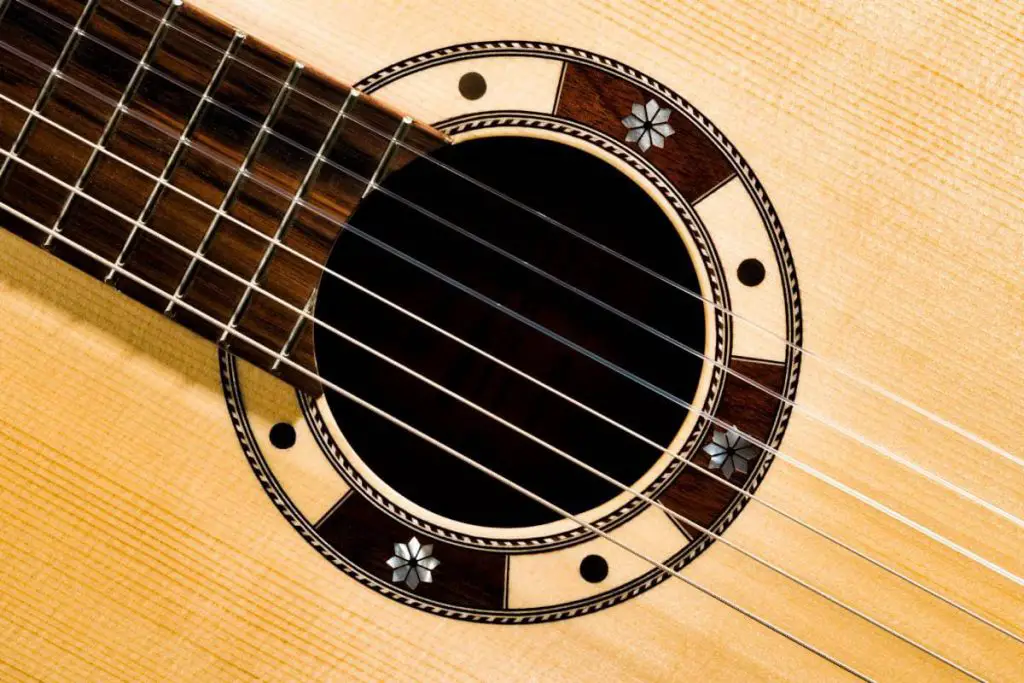
The variations are there primarily for aesthetic reasons, but they sometimes change how the guitar will sound. These sonic differences are not usually big, but they can still be important.
Some other soundhole shapes include:
- F-holes
- Oval holes
- Multiple small holes
- Offset soundholes
- D-shaped holes
Let’s briefly examine these types of soundholes.
F-Holes
F-holes are most common on violins, cellos, and similar instruments. They were later copied by guitar manufacturers seeking to change and improve the sound of acoustic guitars. In addition to looking really stylish, these guitars have a more twangy and mellow sound.
For example, B.B. King was a famous lover of f-hole guitars. They’re obviously great for blues, but also rockabilly and other genres that don’t require aggressive riffing.
F-holes are common on archtop acoustic guitars and hollow-body electric guitars, giving them a recognizable shape.
Oval Holes
Oval soundholes are particularly popular among jazz players. Django Reinhardt was a legendary jazz guitarist who played a guitar with an oval soundhole.
The sound difference is not that noticeable, but some players say that they have more sustain compared to f-holes and that there are more low-mids and less top in the tone.
Multiple Small Holes
Some Ovation and Godin guitars are known for having multiple smaller holes strategically placed on the guitar. These holes are typically offset, changing the tone further. There are also guitars with two small soundholes: one at the top of the guitar and the other at the bottom.
Offset Soundholes
Some guitars have smaller soundholes placed at the top of the guitar soundboard instead of under the strings. This makes them look spectacularly cool, but this design choice has an influence on the sound.
These guitars sound slightly mellower and warmer than regular guitars. This makes sense because the air can’t escape the guitar that easily, and thus has to travel more around the guitar’s body.
D-Shaped Soundholes
In some rare cases, the soundhole on a guitar can be D-shaped. This is quite rare nowadays, and only present on the so-called gypsy guitars. These soundholes are present in part because of tradition, but they’re also adapted to specific types of music—for example, gypsy jazz.
A common piece of wisdom says that D-shaped soundholes work best for rhythm because they have a stronger bass response, while oval ones are best for lead. However, you’ll often find cases where this is reversed.
The truth is that it’s mostly a personal preference—besides, the difference in sound between the two shapes is minimal.
When To Cover a Soundhole
You may have noticed that guitarists sometimes play with the soundhole covered by a circular piece of rubber. This is a feedback suppressor, and it’s there to eliminate feedback on electric-acoustic guitars. It does a terrific job at this, and it can save you many headaches during a gig.
It might also be a way to slightly dampen your guitar and make it less loud. This can be helpful if you’re playing in a flat or dorm and don’t want to disturb your neighbors. A feedback suppressor might remove some stubborn bass frequencies that penetrate walls easily. Your neighbors might not hear you at all, or at least they won’t hear you as much.
If you want to silence your guitar, getting an acoustic guitar silencer is a great choice. It costs next to nothing, but it completely eliminates your guitar’s sound, so you can jam even when the people around you are asleep.
No-Soundhole Guitars
Considering the importance of soundholes on guitars, it’s logical to assume that it’s impossible to build a guitar with no soundhole. But even though it’s not easy to pull off, it’s certainly possible. Guitars with no soundholes exist, but they are few and far between.
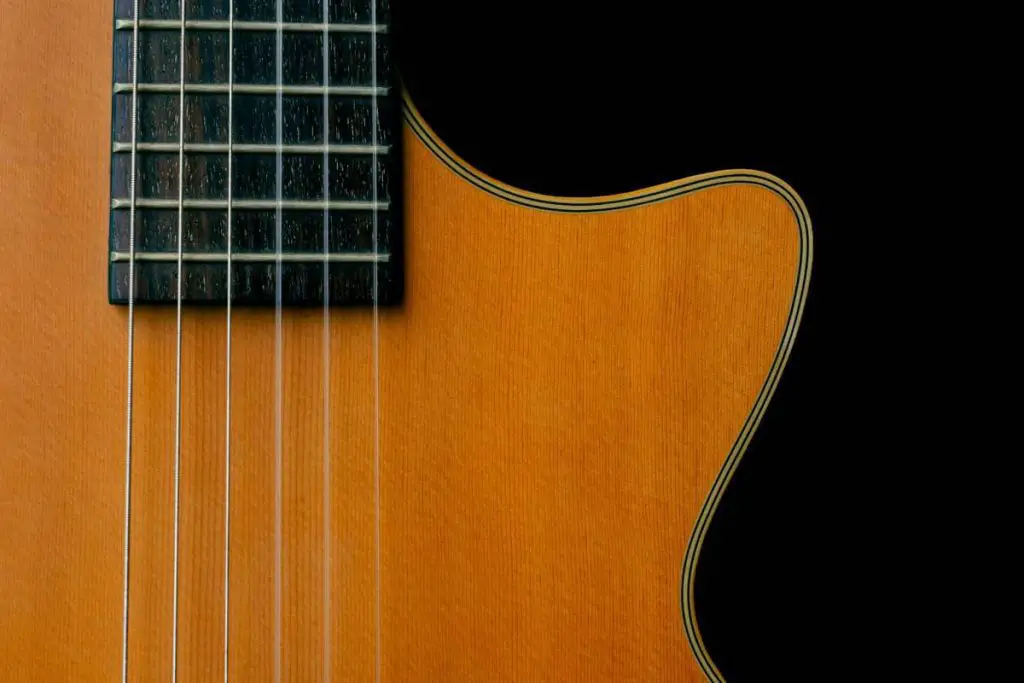
Those guitars sound a bit muted, less open, and less bright. This does not mean they sound bad—they’re just different, and for some musicians and types of music, that kind of sound might be preferable.
No-soundhole guitars are also quieter, making them a good choice if you don’t have enough personal space or a soundproofed room where you can practice without bothering other people.
Another kind of guitar that has no soundholes is silent guitars. Silent guitars are solid-body guitars that don’t have typical pickups. When the strings are plucked, the guitar produces no acoustic sound.
These guitars rely on piezo-electric pickups to amplify the sound when necessary. Even though piezo-electric pickups are older than magnetic pickups, they’re not used very often. And when they are used, they’re used on electric-acoustic guitars and on silent guitars. Electric guitars with such pickups are extremely rare.
Piezo-electric pickups rely on measuring the pressure of the vibrations of the strings to create electrical signals. These pickups contain compressed crystal that receives the signals before they are preamped and sent to the guitar’s output.
Silent guitars don’t need soundholes because of what they’re meant to do and how they do it. Typical electric guitars don’t have soundholes, but that goes without saying. However, some do, and they’re worth examining.
Electric Guitars With Soundholes
Some electric guitars are built with soundholes. Even though it might seem unnecessary, these soundholes often play a role that’s more than just looking cool.
Electric guitars with soundholes are always semi-hollow or hollow-body guitars with f-holes. Guitars inspired by older designs typically have two f-holes, while some more modern designs have only one f-hole.
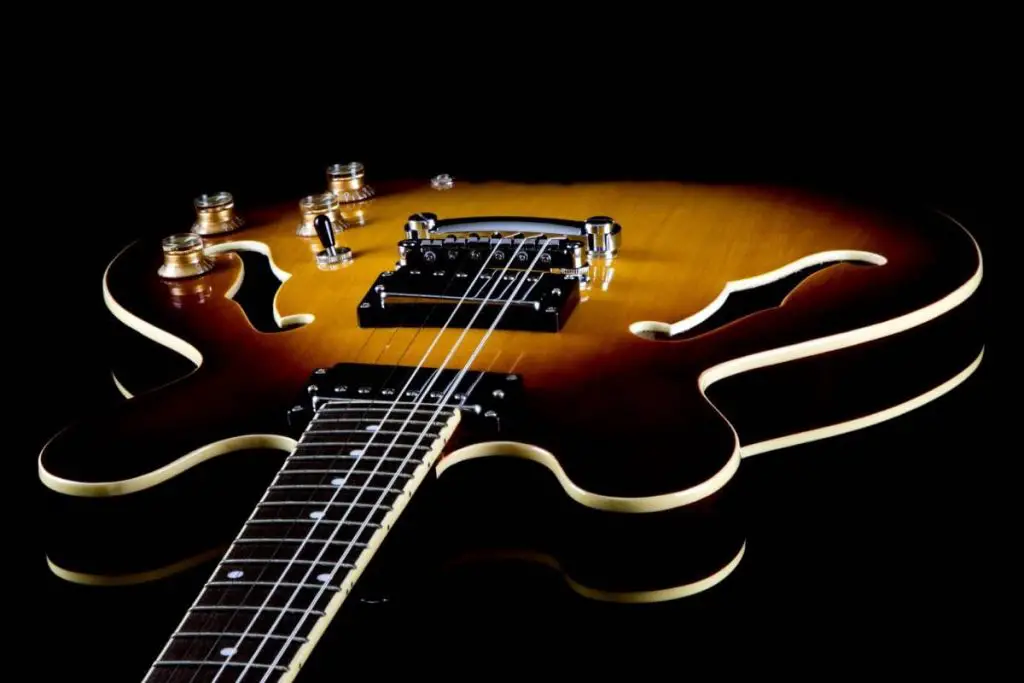
The first electric guitars were based on archtop guitars with f-holes and simply copied the visual design, including the soundholes. These guitars became quite popular among rockabilly artists and soon became a staple in the aesthetics of rockabilly and early rock’n’roll in general.
This aesthetic appeal ensured their popularity in the coming decades, and they are still loved by many guitarists. But although the role of the f-holes is primarily aesthetic, but they might have an influence on the sound of these guitars.
Many guitarists would say that f-hole guitars have more sustain than other guitars. Furthermore, electric guitars with soundholes typically have a softer and mellower sound, which sounds great in blues and rockabilly.
It’s questionable to what extent the f-holes have an influence in sound, apart from the sustain. However, when it comes to hollow-body guitars, the effect is much more pronounced.
Hollow-body guitars have a way more acoustic sound than other electric guitars, owing precisely to the f-holes. They also sound much louder than typical electric guitars when unplugged.
This trait makes them a great choice for those who need an electric guitar, but also want to practice quietly while still being able to hear themselves.
Amplifying an Acoustic Guitar
We have already established that the sound of an acoustic guitar is amplified by the soundhole. This works well enough when you practice on your own or when you play to a small room of people. But for concerts and bigger gigs, your guitar has to be amplified somehow.
This can be done in three ways:
- By miking the guitar.
- By installing soundhole pickups.
- By installing piezo pickups.
Miking the Guitar
Miking your acoustic guitar is the easiest way to amplify its sound. It’s rather easy to pull off. It’s mostly done in recording studios, but if there’s no other option, it can be used for live shows as well.
The most important thing to remember is not to place the mic right in front of the soundhole. Ideally, the mic should be placed 12 to 16 inches away from the 12th fret. If you place the mic directly in front of the soundhole, you’ll lose most of the detail because everything will be suffocated by the booming bass frequencies from the guitar.
Recording engineers mostly use condenser mics for recording acoustic guitars because of their sensitivity. However, you can also play around with dynamic microphones if there is no other option. It might still sound quite good.
Soundhole Pickups
Soundhole pickups are super easy to install and work pretty well most of the time. They work similarly to the pickups on electric guitars: by picking up the vibrations of the strings and turning them into electric signals that can be amplified later.
They sound relatively warm and have a nice tone, making them a pretty good choice. A big downside to these pickups is that they are susceptible to feedback. That’s why guitarists often employ feedback suppressors to improve their sound.
These pickups are also very visible, wich makes them not particularly aesthetically pleasing. They are placed over the soundhole, close to the neck, and look a bit like they were improvised. They might even get in the way if you like to strum close to the neck.
Despite their flaws, soundhole pickups are an efficient way to amplify the guitar’s sound with decent results. If you don’t mind how it looks and can deal with feedback easily, they can be a good choice.
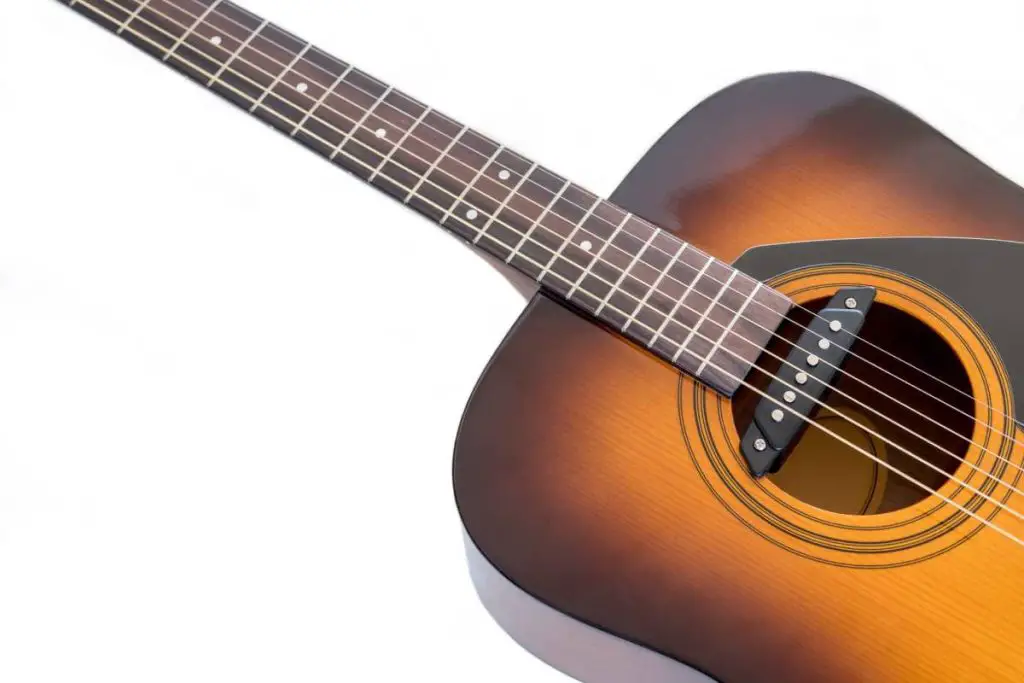
Piezo Pickups
Piezo pickups are the most popular choice for electric-acoustic guitars. They’re not visible and thus don’t affect how your guitar looks. On the other hand, they’re a bit complicated to install, and you’ll most likely need a pro to do it for you.
One great feature of these pickups is that they are not susceptible to feedback because they detect vibrations from the wood rather than from the strings. This means that you can play carefree, without doing anything to suppress feedback.
Piezo pickups sound bright and clean and produce a great sound. The major downside is that they require a preamp, unlike soundhole pickups. They produce a very low signal that needs to be boosted before it gets to the amp. This compresses it a bit and makes it sound somewhat nasal. Some guitarists like the compression, though, so it might be down to personal preference.
Piezo and soundhole pickups cost roughly the same, but you’ll also have to pay installation costs if you get a piezo, which makes them a bit more expensive. You can also combine the two, but this can get expensive and complicated if you are not a pro. You can even use a microphone in addition to pickups, but there is usually no need.
Conclusion
Acoustic guitars have soundholes because they direct and amplify the sound. They also make soundboards lighter, allowing them to vibrate more easily.
It is possible to build a guitar without a soundhole, but such guitars are extremely rare. Some electric guitars also have soundholes, but these soundholes mostly play an aesthetic role.
Acoustic guitars can come with a variety of soundholes: f-holes, oval holes. D-shaped holes, and even multiple soundholes.
If you need to amplify an acoustic guitar, you can simply mike the guitar or install pickups on your guitar instead—mainly soudhole pickups and piezo pickups.
👇😀👇NOTE👇😀👇
If you want to find out what my recommended guitar gear is, then here is what I recommend on Amazon:
- Fender Cutaway Acoustic-Electric Guitar Bundle (MY FAVORITE GUITAR)
- Snark SN-8 Super Tight All Instrument Tuner (Easiest Tuner I’ve Used😏)
- 6 String Acoustic Guitar Capo (Best CAPO for quick changes)
- Dunlop Max Grip 1.0mm Nylon Picks (Thick Guitar Pick So You Don’t Lose Grip!)
- Universal Guitar Stand (Cheap & Minimalist Guitar Stand I Recommend)
- Levy’s 2″ Wide Quick Adjust Guitar Strap (Best Guitar Strap For Any Level)

